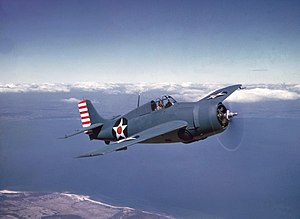
Back Grumman F4F Wildcat Afrikaans غرومان إف 4 إف ويلدكات Arabic Grumman F4F Wildcat Bulgarian গ্রুম্যান এফ৪এফ ওয়াইল্ডক্যাট Bengali/Bangla Grumman F4F Wildcat Catalan Grumman F4F Wildcat Czech Grumman F4F Wildcat Danish Grumman F4F German Grumman F4F Wildcat Spanish Grumman F4F Wildcat Basque
| F4F/FM/F2M Wildcat/Martlet | |
|---|---|
 F4F-3 in non-reflective blue-gray over light gray scheme from early 1942 | |
| General information | |
| Type | Carrier-based fighter aircraft |
| National origin | United States |
| Manufacturer | Grumman |
| Built by | General Motors |
| Status | Retired from military use |
| Primary users | United States Navy |
| Number built | 7,885[1] |
| History | |
| Introduction date | December 1940 |
| First flight | 2 September 1937 |
| Retired | 1945 |
The Grumman F4F Wildcat is an American carrier-based fighter aircraft that entered service in 1940 with the United States Navy, and the British Royal Navy where it was initially known as the Martlet.[2] First used by the British in the North Atlantic, the Wildcat was the only effective fighter available to the United States Navy and Marine Corps in the Pacific Theater during the early part of the Second World War. The disappointing Brewster Buffalo was withdrawn in favor of the Wildcat and replaced as aircraft became available.
With a top speed of 318 mph (512 km/h), the Wildcat was outperformed by the faster [331 mph (533 km/h)], more maneuverable, and longer-ranged Mitsubishi A6M Zero. US Navy pilots, including John "Jimmy" Thach, a pioneer of fighter tactics to deal with the A6M Zero, were greatly dissatisfied with the Wildcat's inferior performance against the Zero in the battles of the Coral Sea and Midway.[3][4][5] The Wildcat has a claimed air combat kill-to-loss ratio of 5.9:1 in 1942 and 6.9:1 for the war.[6]
Lessons learned from the Wildcat were later applied to the faster F6F Hellcat. While the Wildcat had better range and maneuverability at low speed, the Hellcat could rely on superior power and high speed performance to outperform the Zero.[7][8] Wildcat production continued throughout the remainder of the war, with Wildcats serving on escort carriers, where the larger and much heavier Hellcat could not be used.
- ^ Hickman, Kennedy. "World War II: Grumman F4F Wildcat." Archived 2016-12-07 at the Wayback Machine About.com. Retrieved: 15 June 2010.
- ^ Note; British Fleet Air Arm fighters were named after sea birds. Later the "Wildcat" name would be adopted by the RN to simplify supply and prevent possible confusion over delivery orders.
- ^ "TF 16 Action Report". NHHC. Retrieved 20 May 2022.
- ^ "USS Yorktown Action Report". NHHC. Retrieved 20 May 2022.
- ^ Edward, M. (2013). F4F Vs. A6M. Osprey Publishing. p. 60.
- ^ Polmar 2004
- ^ Tillman 1983, pp. 5, 96.
- ^ TAIC REPORT NO.17, November 1944